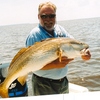09-09-10 JEKYLL & ST. SIMONS ISLANDS FISHING REPORT
By Captain Vernon Reynolds
The definitive term in the local angling community for last week and this coming week is "spring tides". Spring tides occur every year during the fall. Something doesn't sound quite right, right? The spring in "spring tides" refers to the tides springing up, not the season of the year.
The term "height of the tide" is the difference between the low tide and the high tide on any given (in our case six hour) tide cycle. This information is published in tide charts, usually representing six month intervals, but it can be calculated for any date in the future. The tide height changes daily, as dose the time of the tide change. The height of the tide is determined by the gravitational pull of the Moon. When the moon is New or Full the pull is stronger. When the New and Full Moon occur when the Moon is closest to the Earth the resulting gravitational pull is the strongest, spring tides.
The average tide height in our area is about six and a half feet. Normal New and Full Moon phases increase the tide height to about eight and a half feet and last for intervals of four to seven days. Spring tides bring with them tide heights up to ten feet and may last for 10 to 12 days.
"So what," you may say "what dose that have to do with fishing. Well I can tell you a lot, and nothing good. Consider the difference between a six and a half foot tide and an eight and a half foot tide, just two feet. Then consider that the tide changes every six hours and a few minutes no matter what the height of the tide. This means an extra two feet of water must be moved in six hours. I do not know how many hundreds of thousands of gallons of water 24 inches represents but I do know that the current must move much faster to move it in six hours. Fast moving water is not good for fishing. The second thing that happens is the water covers the marsh during the high tide phase. This dose not happen on smaller tides, but when it dose happen the higher tides draw the mud out of the covered marsh on the out going tide which in turn causes the water to become muddy. After a couple of days the water looks like chocolate milk. Not good for fishing. The third thing that happens is high water floats the dead marsh grass, drift wood, sticks and other debris out of the marsh and into the water. It's difficult to fish when you have to keep reeling in to remove trash from your line. Not good for fishing.
The spring tides started September 4th and will run through September 13th. The only times to fish during spring tides is a couple of hours before and after the change of the tide. Current slows down and comes to a stop during the change of the tide. This is when fish will try to feed. Other wise enjoy a Dolphin Tour.
Fishing will return to normal around September 15th. Expect Redfish and Trout fishing to be good. Good numbers of small fish of both species have been taken this summer. Many of these under sized fish will be legal in a couple of weeks. The Shark and Tarpon bite should be good through September. Bull Reds show up in September also. High tides do not affect these bigger fish as much as the smaller ones.
COASTAL EXPEDITIONS CHARTER FISHING AND DOLPHIN TOURS is owned and operated by Captains Vernon Reynolds and Eric Moody. Contact us at (912) 265-0392 to book a fishing trip or Dolphin Tour or go to www.coastalcharterfishing.com for more information.

